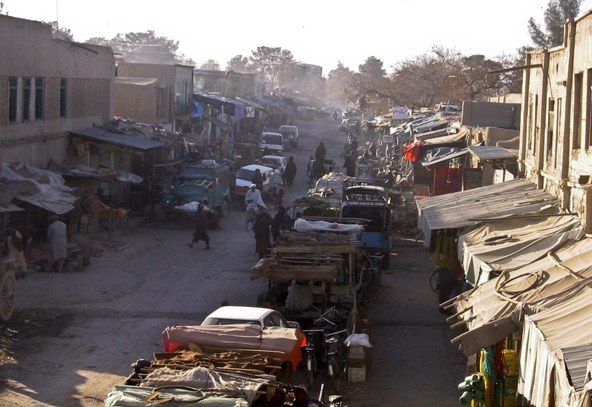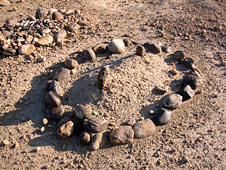
February 2002, Kandahar, Afghanistan. Many people were still sympathetic to the Taliban in this southern city, the site of the former capital under the brutal Islamic regime.
Photo: Phillip Robertson
Finally Maj. A.C. Roper arrived to give the briefing. He got up in front of the cameras (a small thicket of them, standing in the dry fountain) and made a statement about how the Marines are leaving right on schedule and how the 101st Airborne is taking over control of the base. In fact, the Marines, who had taken the airport back in November, were lined up on the grass waiting for their flight out, and I blew it by not going over and talking to them. Roper gave us the traditional acronym-rich progress report, all numbers and letters (objectives, defend and secure, EOD blasts), which only has meaning to a person with a trained military ear. Then, at the end of the prepared statement, Roper said, "The enemy is looking for complacency and we can't afford to give him that." It didn't seem like it bore any relation to reality, but it wasn't really his fault. Roper kept it short.
After a few desultory questions were thrown out, a reporter walked up and said, "Major Roper, can you describe the events at Oruzgan a few days ago?" and the mood changed, clicking over into something more businesslike.
"That is still under investigation," he said.
What was under investigation at Oruzgan might be described best by the word "massacre," the result of bad intelligence, or no intelligence, depending on who you ask. The Special Forces had come in heavy. Twenty-one Afghan soldiers who were apparently loyal to the new Afghan interim government were killed by U.S.
Special Forces, and 27 others were taken prisoner. The New York Times' Craig Smith, who was in Oruzgan, wrote about a man who had found a message on one of the destroyed vehicles after the attack that said, "Have a nice day, from Damage Inc." Pools of blood were seen near the sleeping mats, and at least some of the fighters had been shot through the walls and windows of one of the compounds. It was a serious mistake by trained teams of killers who were apparently pointed in the wrong direction by rival forces within the town. The Americans may have gotten caught in the middle of a dispute between Afghans over two arms caches from the local disarmament drive. What caused the Americans to act is not clear, and no one is telling.
Later, when I talked to Maj. Roper privately, I could see that he was doing the best he could for the press, but that he really couldn't say anything that made sense. Then we talked about his straight- A daughters back home near Birmingham, Ala., his big yarda peaceful suburban vibe. For a second, we could have been at his house, drinking beer from cans, musing about how sweet life was. On the way out to the perimeter, I stopped by the terminal to get a press affairs officer, and we walked past the apron where Apache helicopters were being taken out of crates and assembled, out to a tent where Pfc. Joshua Blomeyer from Pasadena was hanging out with his friends.
Blomeyer had a black eye, and he knew more about the situation than all of the officers I'd spoken to so far. Out at its edge, the base had a half-finished look, intensified by the wreckage of old Soviet transport aircraft. There had already been at least one firefight out at the Kandahar airport, but it had happened three weeks before when the Marines still had the base, and Blomeyer hadn't seen it happen. "Talk to the lieutenant, he was here." I wanted to stick around but the press affairs officer had come back and put a chill on the conversation. Lt. McDonough told me about the firefight, how the enemy had found a high avenue of approach to the airport that enabled them to easily fire on it from a distance. There were also irrigation ditches out there that made it easy for people to move around outside the perimeter without being seen. Looking out toward the mountains, it seemed like a patch of featureless desert, but there were holes and furrows, big enough for small groups of fighters to harass the soldiers at the airport. There is a pervasive feeling of vulnerability on the base, of being exposed.
"Those were left by the previous soldiers," the press guy said, when we came across the graffiti just behind the perimeter. I saw a low building with a series of cells or storage sheds and each one had writing on it, like someone had gone mad, giving titles to each one. Over every doorway, there was a message in black paint. "Valhalla," "The Pit," "No Limit H.Q." I thought another said "Lynch Center." The paint looked just like the stuff used to write the giant "Texas 17" on the control tower for the airport, a call sign for the marines who had taken it. I came back to the base two days later, to see if I could get a glimpse of the al-Qaida prisoners. Since it was forbidden to walk over toward the fence and look in, the trick was to ask about the air traffic control people in the tower and go up there. From the tower, it's possible to look down into the prison, at least one big section of it. Capt. Rivers took me over, once I explained what I wanted, and we climbed the stairs into the tower, where two men were directing traffic without the benefit of radar, using only visual flight rules and radio contact to make sure everyone was where they were supposed to be. It was possible to see everything from up there, to get the feeling of the whole operation. A fire was burning some distance away, letting out a long coil of black smoke. The fire was left over from the controlled destruction of Taliban explosives, a blast that shook the windows of the terminal building. Helicopters waited on the pad. Everywhere something was being built. Small groups of Special Forces soldiers drove in small Land Cruisers, bearded, most of them in sunglasses.
The prisoners were milling around in blue jumpsuits in the enclosure, watched over by soldiers in eight guard towers. One man was being carried like a piece of furniture by two big soldiers, his arms tied behind his back and his knees bent. They put him on the ground, then lifted him up by his arms and took him to another building where we lost sight of him. It didn't seem from that distance like the soldiers were mistreating him; later I saw the Red Cross people move in and out of the camp on one of their regular visits. The Red Cross asserts that the men are in fact prisoners of war and not "detainees," an argument that the Bush administration dismisses as irrelevant. Capt. Rivers said that they were down there giving some thought to what they had done, but I wasn't so sure of that.
A few minutes later, three attack helicopters came in to fly past the tower in close formation, three angry insect angels; they made a graceful turn and flew low, less than 500 feet, over the perimeter where anything could have happened.
As the machines swept past, the very last lines of "I Might Be Wrong" played in my head, a Delphic oracle's warning of a bigger war, a requiem for an age of peace.
Let's go down the waterfall think about the good times and never look back.![]()
 LEAD IMAGE: January, 2002. Nangarhar provice, Afghanistan. A child's grave in rocky soil.
LEAD IMAGE: January, 2002. Nangarhar provice, Afghanistan. A child's grave in rocky soil.Photo: Phillip Robertson
To contribute or commission a new Afghanistan assignment, click here.
© Phillip Robertson, 2009-2014.
